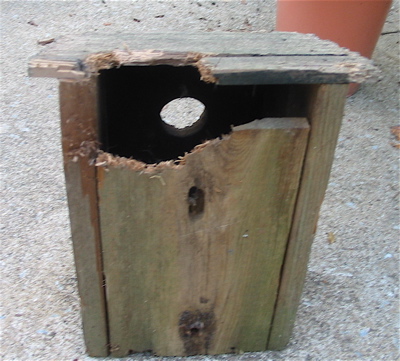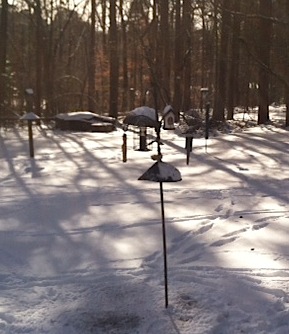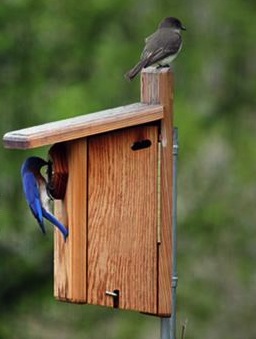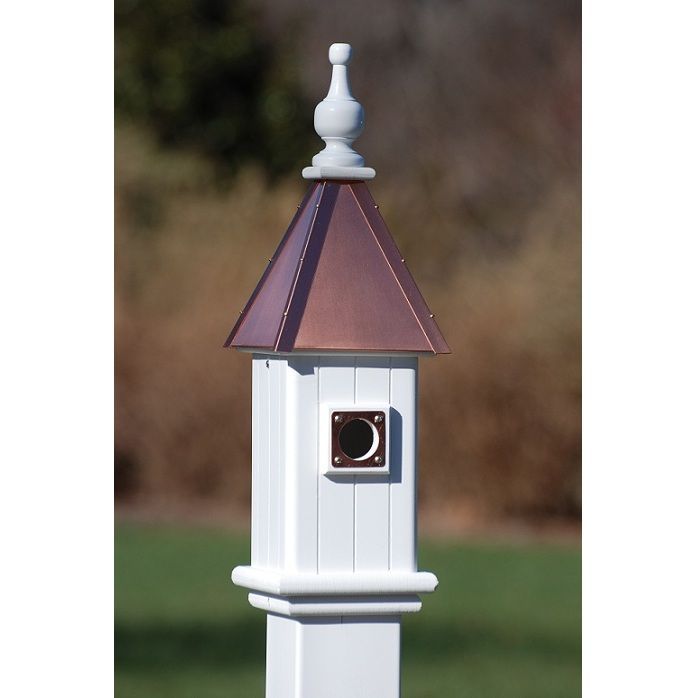-
Friend and Foe Use Bluebird Houses Through Winter
Fairly late and third nesting reports for Eastern bluebirds were common this year, possibly due in part to the previously treacherous winter and their delayed instincts for claiming territories and nest boxes (nest starts).
Now’s a great time to check bluebird houses for repairs and remove nesting materials from the busy spring season. Although bluebirds don’t usually roost in houses… others will! Offering shelter through tough winter months for resident birds is simple if you have a house or two up already. Just clean them out and check for repairs. And a good cleaning is optimal if you have the time, a diluted bleach solution works great. Use a 1:10 ratio of bleach to water and a good scrub brush. Rinse well, let air dry and replace.
Squirrels can do a number on wood birdhouses, especially enlarging the entries to gain access. If the damage isn’t too bad yet, it’s an easy fix by adding a metal or brass portal over the entrance. It’s a good way to save your birdhouses for the birds and deter squirrels through winter. Well… some squirrels anyway!
For the past few years we’ve had a downy woodpecker who claims a bluebird house for nightly roosting, it’s actually pretty cool! House sparrows on the other hand, should be discouraged from roosting in any houses… they’re a major foe of the bluebird and most native cavity nesting birds.
If and when you do go to clean out houses, you may see droppings which will give you a clue as to who’s roosting in there. If they’re white, you can bet house sparrows are in the area. Black droppings with seeds indicates bluebirds. Let’s hope for the latter 🙂
-
They’re Scouting Bluebird Houses Already!
Despite adverse conditions of the polar vortex and another extreme winter, bluebirds and others are on the move, searching for suitable digs to raise their young. Even though snow is covering most of the country, Mother Nature’s biological clock tells them it’s time, the calendar and number of daylight hours is what lets them know.
Early migrating birds on the Atlantic Flyway like swallows, warblers and flycatchers rely on insects as they island hop through the Caribbean onto Cuba. When making landfall along the gulf states, their usual smorgasbord of insects, flowers, fruits and berries will be be scarce. Many neo-tropicals, including hummingbirds run the risk of depleting fat reserves before they reach spring breeding grounds here in the US. Simply put, if you think the weather has been an inconvenience – it makes life miserable for wildlife as well, and many birds just won’t make it 🙁
Closer to home, over-wintering residents like bluebirds are already checking bluebird houses to claim for nesting and raising their broods. With snow on the ground and high temperatures right at freezing, you can hear birds belting out their breeding songs! If there was a way to say “wait… it’s still too cold!” we most certainly would-but then again, man is no force against nature.
Best we can do is help feathered friends along the way by offering fresh water, food, and birdhouses that are ready for nesting. If you haven’t done so already, please check your bluebird houses and remove old nests. Be sure they are secure, sturdy and ready for vacancy. If you can stomach it, live mealworms are their favorite, but suet, peanuts and sunflower hearts also offer much needed fat and proteins.
An Eastern Phoebe perches atop this bluebird house while the male checks out its interior. Phoebes won’t use these houses, but may take up residence in barn swallow nest cups if you offer them in sheltered areas around your home.
During this treacherous weather… please help birds and wildlife with supplemental feeding and a heated water source… thanks on behalf of the birds 🙂
-
Attracting the right birds takes research (pertaining to bluebird houses)
This letter to the editor appeared in The Journal Gazette, Fort Wayne, IN., a few days ago. We thought it might be of interest to those who are newer to backyard birding and so fascinated with all their feathered visitors. Because all songs are not always good ones, we believed this post was in order, especially when adding bluebird houses around your yard.
“Attracting the right birds takes research, effort
Eight years ago, when my husband and I moved to the Spencerville-Leo country area, I decided to put out a birdhouse. Soon our birdhouse was occupied by a pair of bluebirds and five blue eggs. I thought how easy and why was attracting bluebirds thought to be such a hard task? Unfortunately, I discovered the answer. The main problems for bluebirds are house sparrows.
House sparrows are extremely destructive to American species of birds. House sparrows make a point of taking over nesting sites. Sparrows often and viciously take over nesting boxes inhabited by our American species. They trap adult birds in their nesting boxes and kill adult birds by pecking the skulls. Sadly, sparrows most notoriously attack the baby birds also. Sadly, in one summer I have lost as many as 11 bluebirds, mostly attributable to the sparrow and another non-native American bird, the starling.
If you are thinking about feeding birds or housing birds in your backyard, please be aware of what types of birds you bring into your area. Monitor your nesting boxes often to make sure you are attracting the birds you desire.
Now I feel like I’m starting over attracting bluebirds, but they are well worth the effort. As for my personal opinion toward house sparrows, they are nothing but trouble.
LAURA McCANN Spencerville”
Not all sparrows are bad, so it’s best to familiarize yourself with their identification by their song and plumage. Simply do a search for the ill-willed, non-native bird, and images with tons of resources will appear. Note the differences in male, female and juvenile birds as well. If you are serious about attracting bluebirds to your place, this information will serve you and the birds very well!





